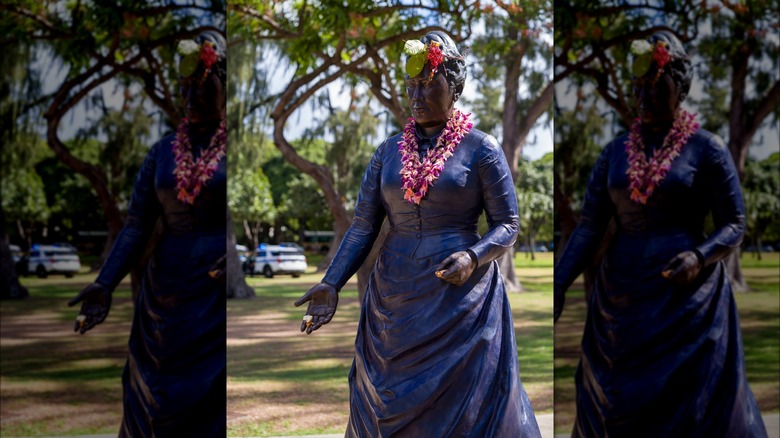One Of The Oldest Public Parks In Hawaii Is A Beautiful Family-Friendly Spot Full Of Activities
While Waikiki and its balmy, bustling beaches, as well as Diamond Head and its iconic hike, might be some of the most well-known Honolulu tourist destinations, don't sleep on Kapiʻolani Regional Park, especially if you're traveling with family. The popular park is situated between those two famous destinations, right along the coast, giving it easy access. But it's far enough away from the main drag that it feels like an escape from the largest of the tourist crowds. It does still have easy access to the ocean, but the beaches here are much less crowded than farther up in Waikiki. Inland, there are sidewalks and trails to take you through the grassy park with tennis courts, soccer fields, a duck pond, and more, with plenty of space to let kids run around and have fun.
Be sure to check out the hour-long Kilohana Hula Show every Sunday through Wednesday starting at 9:30 a.m. at Tom Moffatt Waikiki Shell. Best part? It's free! This show is the latest iteration of a free hula show in Kapiʻolani Park. It follows in the footsteps of the famed Kodak Hula Show, which ran from 1937 to 2002, so it's a classic way to enjoy the authentic Hawaiian tradition.
Kapiʻolani Park is great for nature lovers and artists
For families who love nature, the Waikiki Aquarium at Kapi'olani Park is small but mighty. It's a great place to learn about Hawaii's wildlife with exhibits on the endangered Hawaiian monk seal, colorful tropical fish, and native Hawaiian plants. Even if you're not all that interested in the wildlife, it is air-conditioned, so that can make for a welcome respite after hours at the beach. Kapiʻolani is also home to the Honolulu Zoo with hundreds of animals, from native Hawaiian birds to black rhinos from Africa. Even with its diverse range of animals, it's small enough that you can explore it all in a few hours.
The zoo is also a good destination for anyone with art lovers in the family. If you stroll along its exterior perimeter, you'll find an outdoor art gallery that is aptly named Art on the Zoo Fence. Along Monsarrat Avenue, which cuts east and west through the park, a rotating group of local artists hang their work literally on the fence — including photography and watercolor paintings made with coffee.
If you're looking to just take a moment to relax in the shade, there are huge banyan, monkeypod, and ironwood trees in the park. They also make for a perfect place to enjoy a picnic lunch together as a family out of the sun and off the sand. Many of the trees date back to the time when the park was founded in the 1870s.
Kapi'olani Park has a connection to Hawaiian history, and family-friendly hotels are nearby
Exploring Kapi'olani and enjoying the shade of these century-old trees is one way to experience historic Honolulu, and understanding the park's origins will help visitors gain a better appreciation for this green space, which could easily be imagined as blocks of high rises. King Kalākaua, who reigned from 1874 to 1891, dedicated the 200-acre park on Kamehameha Day 1877. He named the park for his wife, Queen Kapi'olani, and there's a statue of the queen in the park that bears her name. From a report at the time in The Pacific Commercial Advertiser about the park's dedication, King Kalākaua was reported to have called it "the first public park of the Kingdom," which would make "this breezy plain a resort and place of innocent refreshment." Even after the overthrow of the Hawaiian monarchy in 1893, the park was kept as a place of free, public recreation.
For a family-friendly place to stay on Oahu near Kapiʻolani, The Twin Fin resort is next to the Honolulu Zoo. It has stunning oceanfront rooms and suites big enough for the extended family, along with amenities like a pool, hula lessons, and free use of beach chairs, stand-up paddleboards, and other beach necessities. At the other end of the park is the Kaimana Beach Hotel, where in-house experiences include learning to make traditional leis and to play the ukulele.


